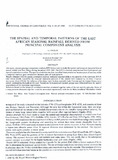| dc.contributor.author | Ogallo, L. J. | |
| dc.date.accessioned | 2013-06-27T15:18:07Z | |
| dc.date.available | 2013-06-27T15:18:07Z | |
| dc.date.issued | 1989 | |
| dc.identifier.citation | International journal of climatology,Vol. 9,145-167 (1989) | en |
| dc.identifier.uri | http://erepository.uonbi.ac.ke:8080/xmlui/handle/123456789/41285 | |
| dc.description.abstract | this study, rotated principal component analysis (RPCA) was used to study the spatial and temporal characteristics of
asonal rainfall over East Africa during the period 1922-1983. The RPCA solutions were derived from both spatial and
.nporal correlation matrices. The spatial correlation matrices described intercorrelation between pairs of stations, while
e temporal matrices gave correlations between pairs of map patterns,
Results obtained with the spatial correlation matrices indicated seasonal shifts in the patterns of the dominant RPCA
odes which closely resembled the seasonal migration patterns of the rainfall belts induced by the Inter Tropical
mvergence Zone (ITCZ). The influence of the large water bodies, especially Lake Victoria and the Indian Ocean, were
iwever, outstanding throughout the year. Twenty-six homogeneous regional groups were delineated from the spatial
.aracteristics of the dominant eigenvectors.
Solutions based on the temporal correlation matrices clustered together some of the wet and dry episodes. Some of
e map patterns clustered together could be associated significantly with the El-Nifio/Southern Oscillation events. | en |
| dc.language.iso | en | en |
| dc.subject | East Africa Inter Tropical Convergence Zone Rotated principal components analysis El Nino/Southern Oscillation | en |
| dc.title | The spatial and temporal patterns of the East African seasonal rainfall derived from principal component analysis | en |
| dc.type | Article | en |
| local.publisher | Department of Meteorology, University of Nairobi, | en |

